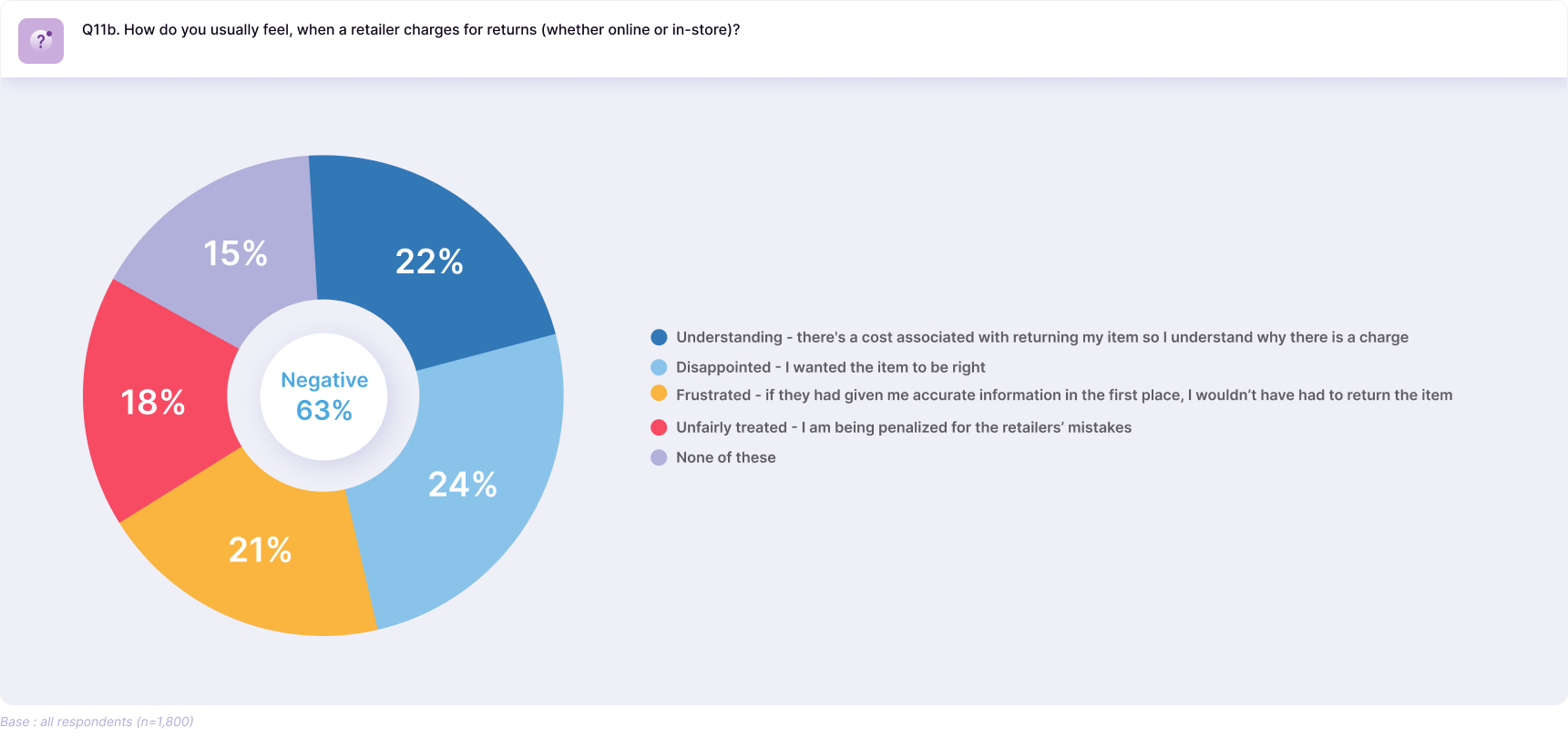Struggling with returns? You’re not alone. Though sometimes inevitable, the returns process can quickly turn sour for both the business and customer as it becomes expensive and cumbersome. Discover these five key strategies for minimizing the need for returns through compelling pre-purchase product experiences.

Keywords
Businesses fear it because of the associated expenses, both in terms of direct costs like shipping, restocking fees, and processing, and indirect costs such as lost sales and negative customer experiences.
And consumers hate the time-consuming and often frustrating process of trying to obtain the item they initially ordered, with 63% of consumers saying that having to return an item gives them a negative view of the retailer.

It’s safe to say that it benefits both the consumer and the retailer to try to minimize the amount of returns. But in a world of “serial returners”, what’s a business to do?
The secret lies in your product information; over half of all consumers (54%) blame the need for a return on incorrect pre-purchase product information. Let’s dive into five effective strategies that your organization can implement today to improve the product experience offered to your consumers and reduce the rate of returns.
A picture is worth a thousand words, and in the realm of eCommerce, it holds even more significance. High-quality visual assets such as product images, GIFs, or videos play a vital role in helping customers better visualize the product before making a purchase. By showcasing multiple angles, close-ups, and colors or sizes demonstrating the product in action, you can provide potential buyers with a clearer understanding of its features, functionality, and overall appeal, reducing the likelihood of a needed return.
Or you could take it one step further – incorporate innovative AR technology by utilizing a 3D product configurator. Imagine you’re in the market for a sofa, and you stumble upon online furniture brand “FurniCo”. Not only do they have high-quality photos of the couch you’re interested in, but there’s also a virtual representation of the sofa, ready to be personalized. You can choose the fabric, the color, and even the configuration of the sofa—whether you prefer a classic L-shape or a spacious sectional. As you make your selections, the 3D model updates in real-time, giving you an accurate visual representation of how your customizations will look in reality and eliminating the guesswork.
You can rotate the 3D model, zoom in and out, and examine the finer details of your customized sofa from every angle. You even have the option to virtually place the sofa in your living room and adjust the size and placement, ensuring that it fits perfectly within your space and assess whether the chosen design and color scheme will blend seamlessly with your existing décor before ever making a purchase.
Few things are more frustrating for customers than discovering that a product they’ve eagerly purchased is out of stock or has lengthy shipping times. To avoid this frustration and potential returns, it’s essential to keep your stock and availability information up to date across all channels. Utilize inventory management systems that sync in real-time to provide accurate information to customers, regardless of where they’re shopping—whether it’s your website, third-party platforms, or physical stores.
When customers can trust that the products they want are genuinely available, they are less likely to resort to alternative options or cancel their orders. By proactively sharing expected shipping times and potential delays, you can manage customer expectations, enhance their overall experience, and significantly reduce return rates.
Let’s return to our furniture company, FurniCo. Let’s say you’ve selected a specific fabric and color combination for your sofa, but FurniCo’s system detects that this particular customization may require a longer production time due to high demand. Instead of leaving you guessing, FurniCo’s website displays a clear notice upfront, stating the estimated time frame for production and shipping.
Furthermore, FurniCo provides the option for customers to sign up for email or SMS notifications regarding stock updates, so that they can be notified when that specific fabric and color combination becomes available. This transparent communication sets realistic expectations and allows the consumer to make an informed decision based on your timeline and needs.
By providing accurate shipping and stock information, FurniCo minimizes the likelihood of returns due to unexpected delays or out-of-stock situations. Customers can confidently plan their purchases, knowing when to expect delivery and having reassurance that their customized furniture will be available as specified.
Accurate and reliable product descriptions are the backbone of a successful digital commerce strategy. They instill confidence in customers and foster trust in your brand. Make sure your product descriptions are comprehensive, covering essential details such as size, dimensions, material composition, care instructions, and any other relevant information that might influence a customer’s purchasing decision.
Understanding the crucial role that accurate and comprehensive product descriptions play in reducing returns, our friends at FurniCo include a comprehensive description that covers essential details such as dimensions, materials, construction, and care instructions on every product detail page.
To enhance the clarity of the information, FurniCo utilizes a combination of concise written descriptions, bullet points, and detailed measurements specifying the height, width, depth, and seating dimensions for every sofa. If any changes occur, such as improvements in materials or slight design modifications, they promptly update the information on their website.
To further support customers in their decision-making process, FurniCo incorporates customer reviews and ratings on their product pages. This valuable user-generated content allows potential buyers to gain insights from previous customers who have purchased the same item.
By providing detailed and up-to-date product descriptions, FurniCo minimizes returns caused by misaligned customer expectations. Customers can confidently evaluate the furniture based on accurate information, ensuring that the dimensions, materials, and design align with their requirements. This transparency and attention to detail result in a higher level of customer satisfaction and a reduced likelihood of returns.
Every channel has its own unique characteristics, and tailoring product information to suit each platform is crucial. Whether it’s your website, social media platforms, online marketplaces, or physical retailers, adapt your product information to the context and format of each channel.
Consider optimizing content for search engine visibility on your website, providing concise and engaging descriptions on social media platforms, and ensuring that your product information aligns with the expectations of specific retailers. By delivering tailored information, you enhance the customer experience across various touchpoints, leading to more informed purchases and fewer returns.
Let’s take a look at how FurniCo can personalize their product information for different channels:
Advancements in technology continue to reshape the digital commerce landscape, offering innovative solutions to common challenges. Embrace these technologies to provide customers with unique experiences and new ways to visualize or understand products to reduce the likelihood of a returned item.
We already mentioned FurniCo’s use of a 3D product configurator, which is a great use of innovative technologies. But FurniCo could also take advantage of the advancements made in AI to FurniCo to enhance the product discovery process and provide personalized recommendations. By analyzing customer preferences, browsing behavior, and past purchases, AI algorithms can suggest furniture pieces that align with individual tastes and styles. This personalized approach helps customers find the furniture that best suits their needs, increasing the likelihood of a satisfying purchase and reducing the chances of returns due to style or design mismatch.
AI can also be utilized in chatbots or virtual assistants, which could be available on FurniCo’s website or mobile app. These AI-driven assistants can answer customer queries, provide real-time product information or shipping updates, and assist with the customization process.
Leveraging your product information to provide a stronger pre-purchase customer experience is the best defense against the dreaded returns. Both businesses and customers benefit from better utilization and syndication of accurate and detailed product information; businesses can enjoy increased customer satisfaction, reduced operational costs, and strengthened brand loyalty. Customers, in turn, experience a seamless and personalized shopping journey, making confident purchases that align with their expectations.
Interested in learning more about how to reduce the rate of return, and what else is top of mind for the 2023 consumer? Download the results from our 2023 B2C Global Survey today!

Explore why outdated SEO tactics no longer meet the demands of today’s search behavior—and how to adapt. From intent-focused strategies to the...
Read more
Learn how brands like Perplexity, Sephora, OpenAI, and Amazon are leveraging AI to reshape the customer journey—from intent-based search and...
Read more
Leading analyst firms IDC and ISG have released their 2025 assessments of Product Information Management (PIM) and Product Experience Management...
Read more